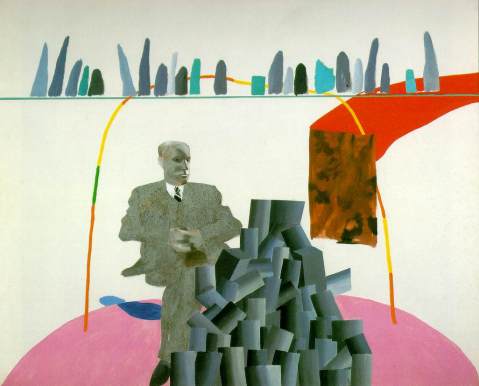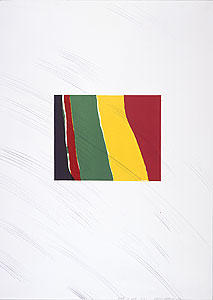Picture of the Month – Portrait Surrounded by Artistic Devices
Exactly a week on from the Oscars triumph of the very English ‘A King’s Speech’, I’ve just been re-watching Colin Firth’s first on-screen stammering in Pat O’Connor’s ‘A Month in the Country‘ (1987) and reveling in the bucolic portrayal of deepest Yorkshire, also a reflection on the art and craft of painting, so my choice this time out is a painting by one of Yorkshire’s greatest sons, David Hockney, and the theme of Hollywood runs through this.
My first job out of college was for film production company Buzzy Enterprises. One of my bosses there was Roger Deakins, pipped to the post last week for the Best Cinematography Oscar by Wally Pfister (for ‘Inception’), Roger’s work on the Coen Bothers’ ‘True Grit’ recently earned him the BAFTA. One of Roger’s partners was Jack Hazan, director of the landmark British cinema verite film ‘A Bigger Splash‘ (1973) featuring Hockney and his circle, including fashion designer Ossie Clark; his wife, textile designer Celia Birtwell; Peter Schlesinger and Henry Geldzahler. The latest user-generated review of it on IMDB is none too flattering but brings me nicely to my picture, Portrait Surrounded by Artistic Devices (1965). This is what Jaroslaw99 of Michigan makes of the film: “Why was the naked swimmer pressed up to the “window” while two others ate dinner, obvlious? Sometimes I think just because the “critics” or “art aficionadoes” can’t understand art or film, they think it is “deep”. That is what I think of David Hockney (the art was mostly one dimensional like grade school children’s) and the same for this film.”
Portrait Surrounded is very much about dimensions (two and three), representation in art and the border between figurative and abstract painting.
The two things I always liked about Hockney is his profound respect for Picasso (in common with Birtwell whose prints were strongly influenced by Picasso and Matisse) and his cheeky sense of humour. I rank Picasso with Bacon as the two greatest artists of the last century. In this painting the use of the phrase “artistic devices” and their very literal depiction in the painting typify Hockney’s playfulness and deflation of the stuff of “critics or art aficionadoes”.
The person portrayed is partly obscured by a pile of (obviously painted) cylinders. Above his head is a shelf on which are a selection of large brushstrokes. The cylinders are crude 3D representations, obvious devices or techniques, which stand out as abstract in a still figurative world of suits and rugs and shelves. The shelf is just a 2D line. The strokes on the shelf are more flat, abstract components of painting, exposing the technique and undermining the illusion. The pile of cylinders is actually painted on a sheet of paper glued to the canvas to leave the viewer in no doubt as to the artifice, physical materiality and flatness of the endeavour.
Cezanne, one of the fathers of Modernist painting, was keen on the simplification of natural forms into their geometric basics – to “treat nature in terms of the cylinder, the sphere, and the cone” (letter to Emile Bernard 1904). Portrait Surrounded is part of Hockney’s on-going questioning of the received wisdom of Modernist painting in the wake of his spell at the Royal College of Art (with the likes of RB Kitaj) and his struggle to find the right balance between abstraction and figurative art.
The person portrayed in this picture is Hockney’s father and the artist is playing out a battle in it between the technical demands of representing the three dimensions of the physical world and the desire to capture the greater depths of emotion and sentiment, like the feelings one has for one’s parents. In his autobiography Hockney wrote: “the thing Cezanne says about the figure being just a cone, a cylinder and a sphere: well it isn’t. His remark meant something at the time, but we know a figure is really more than that, and more will be read into it… You cannot escape the sentimental – in the best sense of the term – feelings and associations from the figure, from the picture, it’s inescapable. Because Cezanne’s remark is famous – it was thought of as a key attitude in modern art – you’ve got to face it and answer it. My answer, of course, is the remark is not true.”
His observation is typical of the cycle of revolts and reactions of art (as well of teenagehood) – I believe Cezanne was actually referring to landscape not figures so Hockney is actually refuting something created through the Chinese whispers of art education. But that doesn’t really matter, it helps him ‘face and answer’ a key issue for his practice.
In the summer of 1960 the Tate held a large exhibition of Picasso’s work which Hockney visited over half a dozen times and recalls as “a very liberating influence”. He found in it permission for the painter to experiment and move through styles in his artistic journey. Earlier that spring he had visited a one-man Bacon show at London’s Marlborough Gallery. In that he saw a strong stand against pure abstraction whilst retaining an emphasis on directly affecting the guts and nervous system through paint. Bacon’s devices like leaving bare large expanses of canvas to literally expose the workings of painting soon became incorporated in Hockney’s work. His pure abstracts of 1959 (the year he entered the RCA as a post-grad) gave way to the combination of abstract and figurative, and the revealing of the techniques and devices of painting to make clear that painting is not a description of the world perceived through the senses but an interpretation and expression of it in all its complexity, not least of the messiness of emotion. Partly obscured behind the pile of cylinders and partly flattened by his collagey suit, the point of depth of this picture is in the father’s flesh, his Baconesque hands and more still his face and eyes – in fact the two dark points of his eyes, the two one dimensional parts of the painting are the deepest (so Jaroslaw99 of Michigan and I can agree for a moment on the single point of one dimensionality).
In the 3D world I’ve only crossed paths with Hockney fleetingly – both times when reviewing exhibitions in the early 90s, once at the site of that influential Picasso show and the other time round the corner from the Marlborough at the Royal Academy (1995). He projected an attractive combination of Yorkshire homeliness and Californian glamour.
He moved to California the year I was born and in 1965, just after Portrait Surrounded by Artistic Devices, he made a set of lithographs entitled ‘A Hollywood Collection’. Conceived of as ‘an instant art collection’ for a Hollywood starlet, it includes prints like ‘Picture of a Pointless Abstraction Framed Under Glass’ for which he draws not only the pointless abstraction but the frame and even the reflections on the glass, more playing around with artistic devices in the quest for that sweet spot between the abstract and the figurative where deep feeling and insight reside.
Previous pictures of the month: Mark Gertler / Manet






[…] Picture of the Month: Portrait surrounded by Artistic Devices – David Hockney (a huge Picasso fan) Spread the […]
[…] Portrait Surrounded by Artistic Devices – David Hockney […]
[…] An earlier Picture of the Month featuring a young Hockney at the RCA […]
[…] entertaining if a little rammed, I’d like to dig out my Hockney Picture of the Month, Portrait Surrounded by Artistic Devices, which is in the show of […]